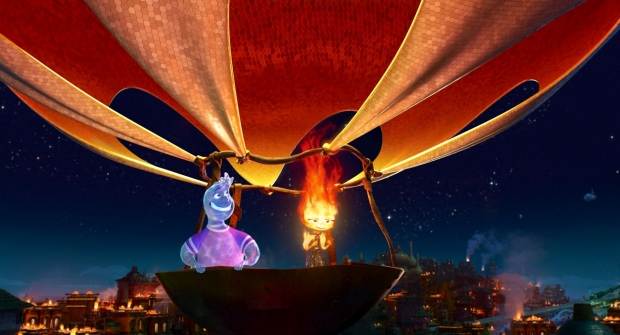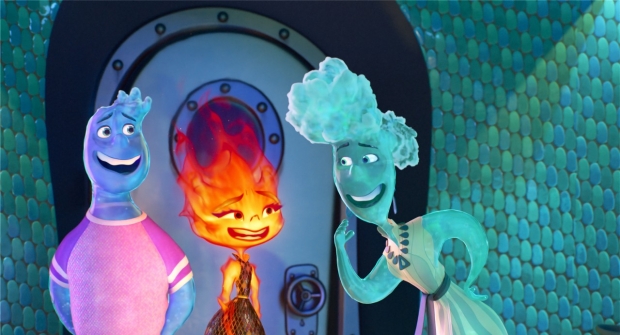The creative team behind Walt Disney Pictures and Pixar Animation Studios’ groundbreaking, all-new, 3DCG feature talks about their hard-won battles with the elements; the film hits theaters June 16.
When director Peter Sohn set out to build a world in which fire-, water-, air- and earth-residents would live and interact, he knew it wouldn’t be a walk in the park. He even suspected it would be a bit more challenging than a brisk run over uneven terrain. Or a barefoot sprint over broken glass. Still, he wasn’t prepared for the creative triathlon (to overextend the metaphor) that comprised the production of Walt Disney Pictures and Pixar Animation Studios’ groundbreaking computer-animated feature, Elemental, hitting theaters June 16.
“I did not know what I was getting into at all,” the director says. “I knew that the characters would be complicated, I knew that there would be a lot of obstacles, but I totally came into it with a hopeful naiveté and excitement.”
The excitement didn’t entirely go away, but the naiveté had an extremely short shelf life.
“Traditionally, when you’re doing a movie like this, you’ve got one world and one culture, with one general type of character that you get to invent,” says Production Designer Don Shank. “For this show, we had four.”
Shank goes on to explain that, as a production designer, he’s tasked with identifying the visual goals of the movie, which typically are worked out in advance by basing the graphic ideas on a movie's theme. But, in the case of Elemental, they were required “to work a bit backwards.”
“Because we knew our characters are made out of elemental effects like fire and water, we needed to first figure out our characters' look and design,” he elaborates. “Then we could create a world and a visual language that would fit these characters in a natural way. The visual themes and goals would evolve from this point organically. At the beginning, it was a bit of a chicken-and-egg-type situation.”
A large part of the challenge lay in the specificity of Sohn’s vision and his determination to realize it. The character Ember (Leah Lewis) is not on fire – she is fire. And her good-natured counterpart Wade (Mamoudou Athie) is not some kind of vessel containing water – he is water. There would be no virtual skeleton-like rig anchoring either character, yet they would need to be able to move and, perhaps even more daunting, emote in a way that was believable and appealing.
“Ember and Wade are unlike anyone we've ever animated before,” says Allison Rutland, who served as one of three directing animators on the film. “They're composed of organic matter with no structure, so that offers an animator so much freedom and flexibility. But we still also had to capture the subtle, thoughtful performances of these two.”
Rutland explains that they wanted the animation to reflect as much as possible the distinct qualities of the elements. “We wanted each element to move a unique way that respected their physical properties,” she clarifies. “We identified things such as weight, flexibility, and fluidity to create a different feel for each of them. This opened the door for us to think of really fun and inventive ways for our characters to move that didn't rely on the restrictions of human anatomy.”
Visual Effects Supervisor Sanjay Bakshi remembers that it took a long time and many, many iterations before the virtual village of collaborators found the just the right creative chemistry to bring Ember to life.
“We tried experiments where we put a cartoony face on realistic fire and it didn't look right,” he relates. “Ultimately, we decided we needed a team of experts to help us, so we squeezed artists, animators, technical folks, and production people in a virtual room and asked them to make Ember in the computer. For weeks, we challenged ourselves to come up with new versions, each learning from the last and applying the ideas to the next. We did the same thing for Wade, slowly tuning the balance between realism and stylization.”
In the end, Rutland notes, where a typical Pixar rig has about 4,000 controls, Ember and Wade had roughly 10,000 individual animation controls each. The result of this prodigious effort was that the animators had a robust toolbox at their disposal for every shot's individual needs, exaggerated or subtle.
Given the unique set of challenges presented by characters who also happened to be fundamental building blocks of nature, it’s hardly surprising that the scale of the effects for Elemental was also unprecedented for a Pixar film.
According to Associate Producer Krissy Cababa, the production required more than 50 effects artists. “We added a whole new department to our pipeline,” she says. “We had two effects teams for this show – one handled those effects we’d normally see, like explosions or floods. The other, character effects, took on all the fire, water, and air characters. That team touched every shot in the movie.”
The team’s leader, Effects Supervisor Stephen Marshall, was uniquely aware of just how different Elemental was from previous Pixar productions, not only in terms of the number of artists, but the ways in which they collaborated.
“On a typical Pixar show, the effects department applies their work after characters have been developed and after animation is complete,” he reveals. “We generally don't have a lot of communication with the characters department, as they tend to be done before we begin. Our main considerations are to avoid obscuring character performance. But, on Elemental, because these are dynamic simulated characters, we needed to work closely with animation and characters, both during early development, as well as during shot work.”
If getting the characters right presented the most formidable challenge in the production of the film, building the world they inhabited had its own set of difficulties. Element City, like a lot of large cities, is made up of districts – although in this case the distinctions are a little more pronounced – and it was important to be able to differentiate them.
“It’s not supposed to be a melting pot, really,” Shank says. “We didn’t want to create this homogenous world. We wanted to celebrate all these different cultures and characters living and working together.”
To that end, they used a kind of color coding – water is generally blue, fire is red and orange, earth is green or brown, and air tends to be purple, lavender or pink – although, as Shank emphasizes, the coloration is subtle, and no place is all one color. Other methods of differentiation involved the shape and style of buildings (for example, the incorporation of shapes reminiscent of cooking in Firetown), topographical features, such as vegetation and waterfalls, and the use of anything that could show air flow – from propellors to clouds – in air areas.
To realize both the complex characters and the similarly complex backdrop, an additional phase of production was introduced to run simulations on the characters in every frame of the film. Additionally, filmmakers adjusted the pipeline to allow more time after animation to tackle the massive effects and complex lighting needs.
A monumental undertaking or just another day/week/month/year at Pixar? Almost 30 years after toys first came to life in three dimensions using computer technology, personified elements are working out their differences in a meticulously imagined world. And they said it couldn’t be done.












